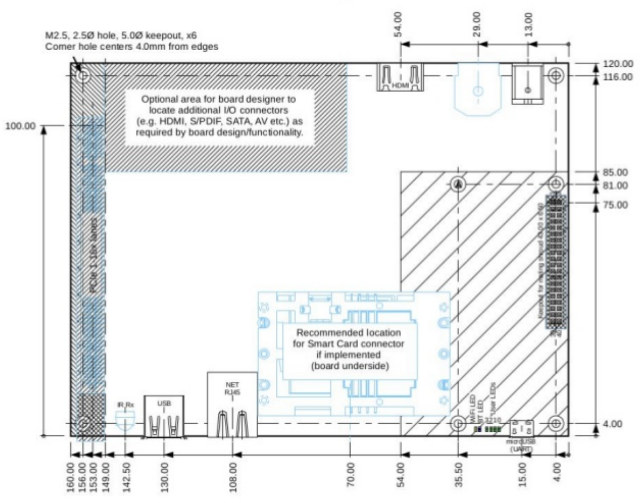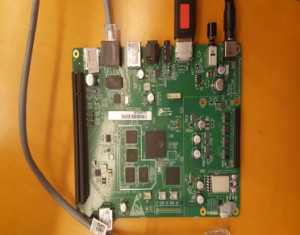96Boards was born as a hardware and software standard with Consumer (CE) & Enterprise Editions (EE), with different form factors with the latter focusing on server boards, but with similar software requirements requiring recent and mostly open source software. The consumer edition was also split into “Standard” and “Extended” editions, which the latter allowing for larger boards with more features, while the Enterprise Edition has its own larger format, as well as an option for micro-ATX form factor. I’ve just learned that a “fifth” 96Boards standard has been worked on with 96Board TV Platform for Home Gateways, OTT Streaming boxes, and TV boards with prices target of $50 or lower for mid-range boards, and $99 or lower for high-end boards.

96Boards TV Platform hardware requirements:
- Dimensions – 160 x 120 mm (EE Standard form factor)
- RAM – 1GB minimum; 2GB recommended
- Flash – 8GB eMMC minimum
- WiFi – 802.11 g/n minimum; 802.11ac recommended
- Bluetooth LE – Optional; at least Bluetooth 4.0

96Boards TV Platform Board by Hisilicon - Video Output
- HDMI 1.4 minimum; HDMI 2.0 recommended
- HDCP 2.0 minimum; HDCP 2.2 recommended
- Optional Video Outputs – Composite, Component, S-Video
- Video Input – Optional same requirements as Video output; used for TV boards
- Audio – HDMI audio mandatory; options stereo I/O and S/PDIF
- Ethernet – RJ45; >= 100 Mbps recommended
- Expansion – 40-pin Low Speed Connector as per 96Boards EE specs
- Additional functionality options:
- User input – Optional IR detector
- Security interfaces – Optional smartcard I/F
- Transport stream I/F – Optional parallel connector for tuner card (ATSC, DVB-T2, DVB-S2, etc…)
On of the software side, the kernel must be buildable from source code with eventual closed-source binary blobs from either kernel.org, latest Google-supported Android kernel version, or one of the latest two LTS kernels from kernel.org. Supported operating systems must at least one of the latest version of Android, Debian, Ubuntu, Fedora, Red Hat, or Linaro / Vendor supported Linux OS built with OpenEmbedded/Yocto Project. The latter being supported by Linaro Home Group (LHG). Other requirements include support for vendor or open source bootloader, optional but recommended OP-TEE support, ARM Trust Firmware, and royalty-free vendor or open source accelerated graphics support. Note that the specifications are aimed at development boards, and not at commercial products. You can find more details in the slides for 96Boards – TV Platform presentation at Linaro Connect Bangkok 2016, as corresponding YouTube video.
I learned about the new 96Boards specifications through the blog post about a “sprint” at the Huawei/Hisilicon facilities in Shenzhen, China on July 11-14. Hisilicon showcased “Poplar” – manufactured by Tocoding Technologies startup – one of the first 96Boards TV platform boards (pictured above), and worked on/demonstrated support for OP-TEE builds on Linux and Android for PlayReady and Widevine DRMs, AOSP TV with TV input framework, LHG OpenEmbedded builds with Yocto 2.1, automatic testing, and so on…
It’s unclear when 96Boards TV platform specifications will be officially released, and when the boards will come to market.

Jean-Luc started CNX Software in 2010 as a part-time endeavor, before quitting his job as a software engineering manager, and starting to write daily news, and reviews full time later in 2011.
Support CNX Software! Donate via cryptocurrencies, become a Patron on Patreon, or purchase goods on Amazon or Aliexpress






in the 11th slide, they recommand the ethernet connector to be placed in front of the board
fortunately it’s not mandatory, but still looks like a fail to me
there is another strange thing i noticed, they never talk about video codecs support nor vpu specs in the slides.
aren’t they the main characteristics in a TV box ?
Potentially another candidate for 96Boards TV Platform STMicro B2260 board -> http://lists.infradead.org/pipermail/linux-arm-kernel/2016-August/448920.html